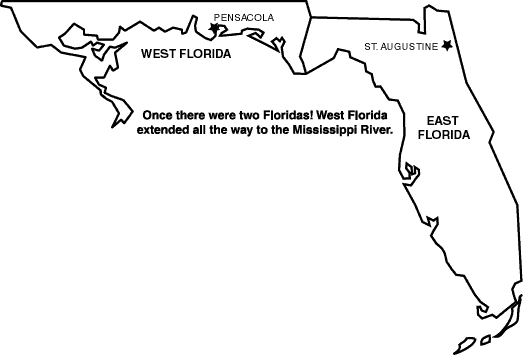| Home > Florida Then & Now > A Short History of Florida > Transfer of Florida | |
Transfer of Florida

Florida Became a British Colony In 1763, France, Britain, and Spain signed the Treaty of Paris at the end of the French and Indian War. As part of the treaty, France gave up almost all of its land in North America and Spain gave up Florida. During the French and Indian War, Britain had captured Havana, Spain's busiest port. In exchange for Havana, the Spanish traded Florida to Britain. The British then divided Florida into two territories: East Florida and West Florida. This time was known in Florida as the British Period.
East Florida
East Florida was then bordered by the Apalachicola River, the Gulf of Mexico, and the Atlantic Ocean. The capital of East Florida was St. Augustine. East Florida had good, fertile soil and was excellent for farming. In an attempt to bring settlers to East Florida, the British offered land grants to settlers who would come to farm and also defend the new British territory.
The first governor of East Florida was James Grant. Grant did more to increase the population of East Florida than anyone else. He remained friends with the Seminole Indians and traded goods with them. Grant also encouraged settlers from North and South Carolina, Georgia, and other British colonies to come and start plantations, or large farms.
Many British brought enslaved Africans with them to work on the plantations. The slaves cleared land, built homes, took care of farm animals, and planted and harvested crops. Many plantations were successful with various crops such as citrus fruit, sugar cane, rice, and cotton. Some plantations raised Indigo plants for making dark blue dye.
West Florida
West Florida consisted of the land between the Mississippi River and the Apalachicola River. It included parts of modern day Alabama, Mississippi, and Louisiana. Pensacola was the capital of West Florida. West Florida had thick pine trees and sand. It was not good for farming and did not grow in population as much as East Florida.
The American Revolution
The British did not rule Florida for long. The colonies north of Florida were tired of Britain's rule and decided to fight for their independence. They began a war known as the American Revolution. During this time, colonists who fought for independence were known as Patriots. Those who sided with Britain were called Loyalists.
Unlike the northern colonies, Florida did not have problems with Britain. In fact, many of the English settlers that lived in East Florida invited Loyalists from South Carolina and Georgia to move to Florida. The majority of these Loyalists settled in St. Augustine.
Most of the war took place far north of Florida, but Florida suffered occasional raids. In 1779, Spain took advantage of Britain's preoccupation with the colonies and invaded West Florida. By 1781, Britain had lost West Florida to Spain. At the end of the American Revolution, Spain regained the rest of Florida.
After the American Revolution
Britain had lost control of the thirteen colonies, and therefore, had little interest in keeping Florida. Florida was still isolated from the original colonies and did not produce big profits for Britain. On September 3, 1783, another Treaty of Paris was signed ending the American Revolution. It was at this time that Britain recognized the independence of the United States.
Although Spain regained Florida, its rule was short lived. The United States now wanted control of Florida. Spain's attempt to bring settlers to Florida failed, and by 1800 Spain's control of Florida had weakened. Gaining control of Florida for the United States would mean gaining control of the Mississippi River. That was an important route for trade. At the same time, Britain also wanted to regain control of Florida.
Finally in 1821, the United States was successful in purchasing Florida from Spain. Florida became a territory of the United States.
Florida's Kingsley Plantation
The Kingsley Plantation, located near Jacksonville, is an excellent example of what plantations were like when Florida was transferred to the United States. The main house was constructed in 1898 by John McQueen. It is connected to a smaller saltbox house and kitchen. The grounds also include a barn and several dozen slave cabins constructed of tabby, a mixture of equal parts lime, water, sand, and oyster shells. The plantation was located on an island to protect it from invaders and to prevent slaves from escaping. Cotton, citrus, sugar cane, and corn were grown here.In 1814, Zephaniah Kingsley moved to Fort George Island and the plantation. He brought a wife and three children. His wife, Anna Madgigine Jai, was from Senegal, West Africa, and had been purchased by Kinglsey as a slave when she was 13 years old. She actively participated in plantation management for 37 years, acquiring her own land and slaves when freed by Kingsley in 1811.
In 1821, the United States purchased Florida from Spain. The Americans replaced liberal racial policies with oppression. To escape what Kingsley called a "spirit of intolerant prejudice," Anna and their five sons moved to Haiti.
Today the Kingsley Plantation is the oldest plantation house in Florida. It is managed by the National Park Service as an historic site and is open to visits by the public.
| Home > Florida Then & Now > A Short History of Florida > Transfer of Florida |
Exploring
Florida: A Social Studies Resource for Students and Teachers
Produced by the Florida Center for Instructional
Technology,
College of Education, University of South Florida © 2002.